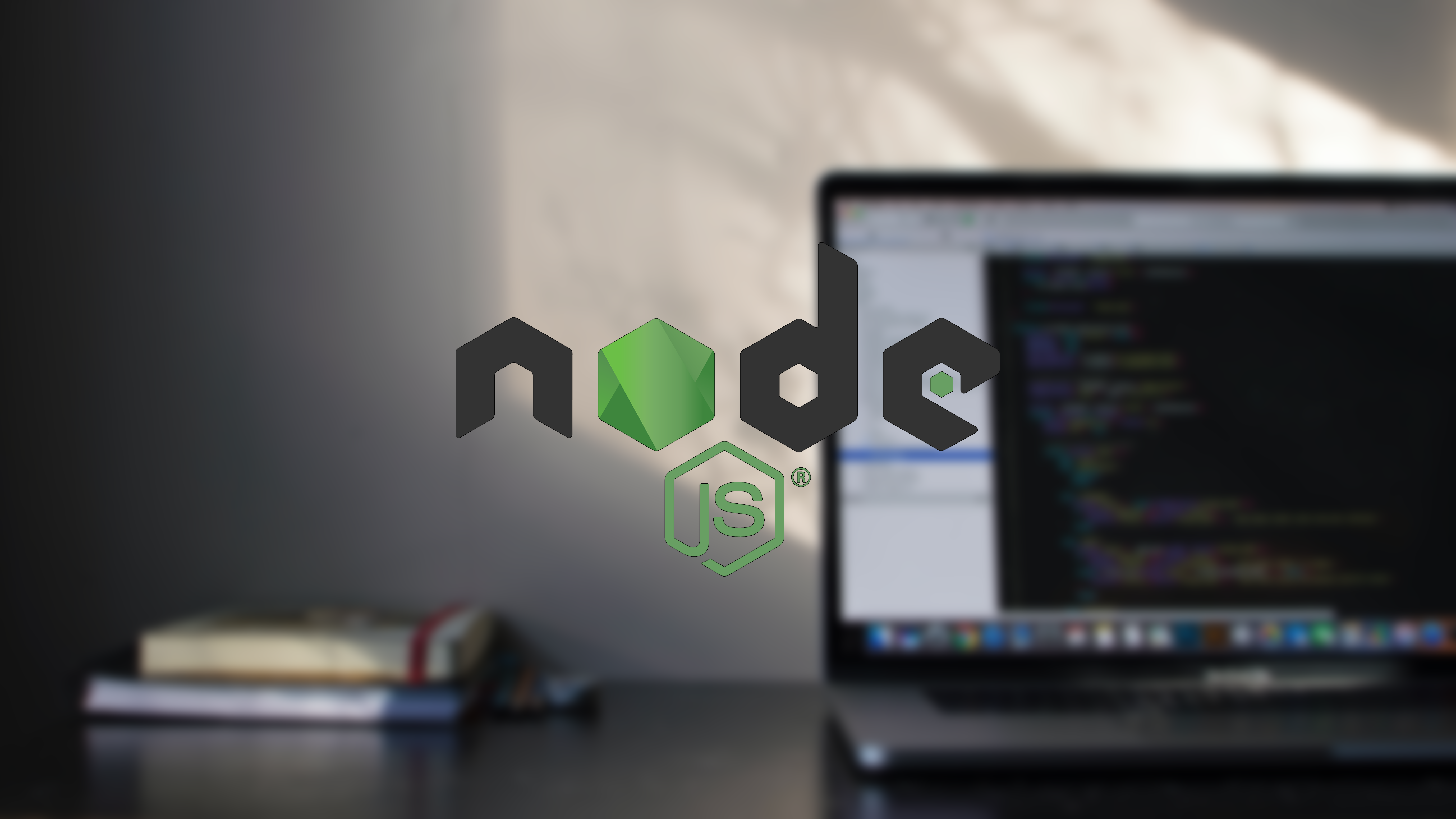
Node.js: The Definitive Guide With Almost Everything You Need To Know
Julian Wallis
35 min read

If you’re ready to take your knowledge of Node.js beyond the basics, this guide is for you. We’ll dive deeply into what makes up Node.js and its journey from inception through today’s hottest frameworks, along with some bonus tips on how to host and maintain applications as well as how it stacks up next to other languages.
Join us now for an information-packed exploration of all things related to Node.js technology!
What Is Node.js & How Does It Impact Software Development? 💁

Node.js isn’t just another server-side programming language; it’s an entire environment and library that can be used to run web applications from outside the user’s browser. This opens up a world of possibilities for real-time, event-driven services such as everyday websites or back end API solutions. All made possible by Google Chrome’s V8 JavaScript engine at its core – simplifying complex tasks without taking away any of their power.
With Node.js, developers can leverage a single “stack” to make building and maintaining websites fast and straightforward, freeing up time for more important objectives like achieving the project’s business goals. And it doesn’t stop there: Unlike most software solutions out there, Node.js is open source, meaning not only that you don’t have to break your budget but also take advantage of its continuous updating from an ever-growing community. The icing on top? You won’t be dealing with frameworks or libraries either, as this environment works independently at runtime.
With a runtime environment, developers benefit from lightweight flexibility and easy deployment. Web APIs provide access to powerful coding capabilities that can be seamlessly integrated into your application project, helping optimise performance and expedite progress.
Node.js History ⌛
In 2009, Ryan Dahl faced a huge problem. Existing web servers were simply unable to manage the high-volume concurrent connections necessary for modern applications and businesses. His frustration at this limitation drove him to create Node.js – an ambitious project that revolutionised server scripting by unifying development around one programming language, JavaScript. Its unique features gave developers unprecedented power to create versatile products with greater user engagement potential than ever before.
Node.js made its initial debut with support for Linux and Mac OS X, but it didn’t stay that way. In 2010, a package manager was released to make coding easier by simplifying the installation process of Node.js packages, saving developers bundles of time and hassle. But it wasn’t until 2011 when Microsoft combined forces with Joyent to develop a native Windows version, making this powerful technology available on even more platforms than ever before.
In a remarkable show of collaboration and community-building, the Node.js Foundation joined forces with The JS Foundation in 2019 to become one powerful OpenJS entity dedicated to helping foster global growth across open-source projects like Node.js.
From Amazon to Netflix, eBay to Reddit and Paypal, giants of the tech world are all taking advantage of Node.JS’s superpowers. Providing a fast and simple development environment that doesn’t sacrifice power or flexibility makes it no wonder why 43% use this rock-solid framework for enterprise applications too. Small business owners looking for innovative solutions should be sure not to overlook the potential offered by Node.js.
Node.js Architecture 🏛️

With Node.js, developers don’t have to worry about limiting their capabilities due to thread restrictions. Its single-threaded design allows for unlimited processing power and flexibility. Instead of having a finite number of threads available from the server’s pool, all requests are processed in sequence on one continuous stream that can keep up with even the most complex tasks. It’s no wonder why this pioneering technology has become so popular among techies everywhere.
For apps with a high number of concurrent client requests, multiple-thread processing can lead to serious slowdowns. This happens when all available threads are being used, and the server is forced to wait for busy ones to become free again, which leads not only to hampered customer experience but even lost conversions or sales opportunities.
Node.js relies on single-threaded processing to maximise the efficiency of web applications’ performance and scaling capabilities. Ryan Dahl crafted Node.js with this in mind, which is why it has become such a favourite among developers.
Node.js Terminologies To Know 📙
Node.js has quite the vocabulary! Let’s get to know these common terms and their companion definitions for a deeper understanding of this popular JS runtime environment.
⌨️ JavaScript
If you’re getting into Node.js, brush up on your JavaScript. This dynamic programming language provides the foundation for tools that can enhance a webpage’s user experience by making it feel more alive and intuitive (think search boxes, embedded videos or news feed refreshers). With its “curly bracket” syntax, dynamic typing capabilities and prototype-based object orientation features, you’ll be able to bring any page from static to interactive in no time!
🧩 Node.js Modules
Node.js provides powerful modules that can be included in your application, allowing you to easily build sophisticated programs:
- Core Module: This ready-to-go module is already part of Node.js when you install and start up your program.
- Local Modules: These help expand upon those built into Core, giving you even more control over designing complex solutions.
- Third-Party Modules: Available from other sources, they fit perfectly within any project or individual context without interfering with others running simultaneously, making open-source software possible and incredibly easy for everyone involved.
Local Modules offer more options for Node.js users to build their own features and functions, while third-party modules offer the convenience of having someone else’s code ready-made so you can focus on your project. Both types of modules provide valuable supplemental tools that help bring any application or website idea to fruition.
🎫 Event-driven Programming
Event-driven programming is essential to modern applications, allowing them to reactively and intuitively respond to user actions in real time. It constitutes a “programming paradigm” – rather than the program’s execution being determined by linear instructions from start to finish. It reacts dynamically to events occurring outside itself, such as clicks or messages. By predicting what users will do next and pre-emptive processing their requests using established event handlers, this method allows for enhanced flexibility when dealing with multiple concurrent activities at once.
🔎 Microservices
Microservices are the building blocks for powerful, complex applications. By separating an app into multiple small components – each designed to work independently from others yet still unified under one application – developers can enjoy greater control and flexibility. And since each microservice is self-contained and manageable individually, updating or modifying a single part without compromising performance has never been easier.

When it comes to building software, there are two different approaches that developers can take. Microservices offer a more agile approach with independent services connected by orchestration and discovery to guide their interactions. However, these processes may not always be the most suitable choice for every project. On the other hand, Monolithic structures provide an autonomous single unit that entirely avoids any issues associated with microservices but could prove problematic when making changes due to its rigid structure. Choosing between them really depends on your specific requirements.
📦 Node Package Manager
Node Package Manager (more commonly known as “npm”) is an indispensable tool for developers working with Node.js projects. It acts as a repository that allows open-source sharing, and its command-line functionality makes accessing those shared programs easier than ever. From package installation to version management, npm provides users with the perfect way to use all of Node’s great tools and packages in one convenient place.
🧵 Node.js Worker Threads
Node.js puts the power of parallelism into your hands with its Worker Threads feature! Using an existing pool of “workers” for handling incoming tasks, you can achieve faster performance and more efficient processing without disrupting the main thread. The worker_threads module gives increased flexibility to tackle CPU-heavy jobs, so get ready for smoother sailing on all sorts of JavaScript projects. It’s time to go full throttle!
➰ Event Loop
Node.js is built on an impressive mechanism known as the event loop, which allows it to perform complex operations in a single-threaded environment without blocking I/O processes. In essence, this means that when multiple tasks are executed simultaneously in Node’s JavaScript runtime, they can be offloaded to your computer’s multi-threaded kernel for processing, helping keep everything running smoothly.
Furthermore, events or messages waiting to run within your program will stay poised and ready with the event loop at its helm, so each time there’s a request needing handling, you know it won’t take long before being processed once all other conditions have been met.
Node delegates tasks and keeps the system running more efficiently than other technologies. Instead of waiting on one task to complete, Node can handle multiple requests at once, making it faster than ever before. All thanks go to the event loop that makes this possible.
Node.js’s Popularity 📈
For years, JavaScript has been one of the top programming languages, and now its use is expanding with Node.js to create innovative applications on diverse platforms. Over the past decade, some major companies have utilised this power: Walmart, Netflix and LinkedIn, to name a few!
Not only do developers benefit from scripting capabilities, but they are drawn in by other features such as non-blocking I/O operations, making it great for fast data streaming apps like real-time analytics or messaging services that need low latency responses.
However, there can be issues surrounding security vulnerabilities, so make sure you think carefully about which project will best suit Node.js before diving in head first.
What Is Node.js Used For? ⚒️
Node.js is an incredibly powerful JavaScript runtime environment that uses event-driven programming to deliver ultrafast, lightweight performance ideal for complex web applications with intense data and I/O needs. Node makes it possible to serve multiple concurrent events in a single thread, helping you quickly scale your application without sacrificing efficiency.
▶️ Streaming Apps
Node.js makes it easy to build applications that stream on demand. You can unlock just the parts you need for bootstrapping, and downloading additional components is as straightforward as opening a valve! Its native Stream API lets us tap into powerful Unix pipes, which let us quickly transport relevant app code directly onto your system, so you never have to wait. Best of all, once every component has been acquired, no network connection is even needed anymore – an ideal solution when maximum performance matters most.

Let the data flow! Streams provide an unencumbered pipeline, offering a direct connection between two points without bulky caches or unnecessary temporary files. Enjoy lightning-fast transfer speeds of your application data with minimal fuss and effort.
🏗️ Microservices Architecture
With Node.js at the forefront, microservices architecture has become increasingly popular amongst major applications like Netflix and PayPal, which have successfully leveraged its benefits since 2013. Express and Koa frameworks make it easy to mount multiple server instances for each service while also designing routing addresses. They create an efficient system that’s been used by companies such as eBay, Amazon and Facebook, revolutionising their monolithic structures into a suite of reliable micro-components.
💬 Real-time Chats
As digital communication continues to become an integral part of everyday life, real-time chat applications are increasingly being used across various industries. Luckily, Node.js makes it easy and straightforward for developers to create these dynamic conversations with its powerful Event API that provides “emitters” emitting named events while event handlers take care of the response, making instant messaging possible.
🚧 Complex Single-page Applications
Single-Page Applications have revolutionised web development, allowing entire applications to fit on one page for a better user experience. From social networking apps and online drawing tools to classic examples like Gmail, SPAs are everywhere. Node.js is the perfect technology partner for building robust single-page applications since its event loop easily supports asynchronous calls and data workloads, ensuring quick transitions between views and seamless updates of new content.
Node.js is in a league of its own when it comes to building SPAs. Developers need only know one language (JavaScript) as many popular frameworks, and social sites (think LinkedIn & Medium) use the same programming code for both client-side scripting and server-side operations. This results in faster development times and better maintainability, meaning you can create an awesome SPA without all the stress.
📟 Internet Of Things (IoT)
The Internet of Things is a vast, interconnected world of technology. Whether it be sensors or actuators embedded with electronics and enabled to send data back and forth, managing all requests across this ever-expanding network has been quite challenging… until Node.js came along! With its ability to process multiple concurrent events emitted by limitless devices at lightning speed, enterprises and organisations have now found an ideal solution for enabling IoT systems in their own spaces since 2012.
Node.js servers are an ideal application layer between the ever-increasing number of IoT devices and their data stores, allowing for fast communication despite the avalanche of requests thanks to its event-driven architecture and asynchronous processing specially crafted for I/O operations on networks like these!
🔧 Real-time Collaboration Tools
Nowadays, real-time collaboration applications provide us with many opportunities to work together seamlessly. Slack, Trello, and Google Docs are some of the most successful programs on the scene right now – offering co-browsing features, project management tools as well as audio/video calls and document editing capabilities.
Node.js is a particularly attractive choice for these types of apps due to its asynchronous event-based architecture, which easily handles multiple user activities occurring simultaneously. It’s like several people all changing one paragraph or posting messages from different devices in quick succession, meaning changes get applied quickly without any lag!
With its event-driven, non-blocking architecture, Node.js is the perfect choice for real-time collaboration and information sharing – just ask Trello! Their engineering team realised that by emitting push notifications through Node.js, they could update their project management application quickly and effectively without clogging up resources. So everyone can stay in sync with a single coherent representation of data at all times!
Node.js Benefits 🎖️
🦾 1. Better Efficiency

Node.js lets you soar to new heights in performance and speed. Its non-blocking I/O system can quickly process a swarm of requests at once, queueing up each one for efficient execution. Your app won’t be bogged down by heavy RAM usage either. Enjoy better scalability levels with Node’s lightning-fast response times.
🦅 2. Higher Flexibility
Node.js is the perfect choice for developers who crave extra project flexibility. It offers an expansive, un-opinionated canvas that allows you to build and customise your application from scratch. In addition, its minimalistic approach ensures tasks can be completed quickly while giving room to make each project unique according to individual preferences or needs.
⚙️ 3. Fullstack Development
Node.js brought full-stack JavaScript from a dream to reality – with one language, two teams have become one. Developers can now combine the client-side and server-side of web applications in an efficient way that was previously impossible. This has made deploying apps much more straightforward than before, saving time and effort for developers everywhere.
🤸🏼♂️ 4. Active Community
The Node.js developer community is a buzzing hive of creativity and collaboration where JavaScript programmers come together to produce spectacular results. Thanks undoubtedly go out to their collective efforts for the array of ready solutions that you can find on GitHub. From cutting-edge codes to tried and tested methods, its ever-growing progress means there’s something new around every corner.
👌 5. Easy To Learn
If you’re a front-end developer with some skills in Javascript, then there’s no need to start from scratch for back-end development. With Node.js, even junior developers can quickly and easily make the transition. Speaking the same language makes it so much simpler. That’s why Javascript is an integral part of modern web development.
Node.js Drawbacks ⛔
Despite its impressive benefits, Node.js may not be the perfect choice for every application project. Let’s look at some of the potential negatives that come with using this powerful tool.
🏋 1. Unsuited For Heavy-computing Apps
Node.js is the ideal choice for complex applications. However, it’s unsuitable when software requires hefty computation, as these processes can hinder incoming requests and lower performance. In addition, multi-threaded programming isn’t supported yet, so those needing to execute lengthy calculations should look elsewhere since Node.js won’t be the hero your project needs.
👶 2. Immaturity Of Tools
As an open-source ecosystem, Node.js and its accompanying package manager (npm) registry offer a wealth of tools but also come with unique challenges. Quality assurance is largely self-supervised within the npm structure; inexperienced developers can easily struggle to identify reliable packages that meet coding standards expected by today’s industry professionals. To ensure success when tackling projects utilising these cutting-edge technologies, it pays off in spades to have experienced engineers on board who know how to navigate this complex environment.

🕒 3. More Development Time
Node.js is often praised for its flexibility, but a lack of direction can be daunting. You’re essentially starting from scratch with every new project. Thankfully, if you have access to an experienced team and established processes in place, then productivity won’t take too much time away. So it’s all about finding the right balance between structure and freedom.
😬 4. Unstable API
Node.js is a powerful tool for building apps quickly, but its ever-evolving API can cause frustration for programmers who need to stay on top of the latest updates and adapt their code accordingly. As if managing software wasn’t hard enough already. Thankfully there are ways around this challenge, such as using wrappers or compatibility layers – helping make sure your development path never turns into an obstacle course.
Node.js Use Cases 🗃️
Have you ever wondered how large companies around the world are using Node.js to create applications and solve business challenges? Check out some of these detailed case studies for a behind-the-scenes look at the use cases of this powerful tech.
📋 1. Trello
Many companies count on Trello for their daily operations, and that’s not without cause. Node.js provided a great solution in the form of its event-driven, non-blocking server capabilities, ideal for instant propagation updates while maintaining lots of open connections. It also proved reliable when they were prototyping single-page applications.
🛍️ 2. Walmart
Walmart is no stranger to risk-taking, having recently jumped on the trendy Node.js bandwagon. It completely transformed its mobile app in a way that provides customers with sophisticated features like never before. With asynchronous I/O and single-threaded event loop models handling multiple requests at once, Walmart’s transition has been nothing short of successful, but don’t take our word for it. Check out this ‘lessons learned’ presentation from Walmart to learn more about how they made the switch smoothly without missing a beat.
💼 3. LinkedIn
LinkedIn knew something the rest of us didn’t: Node.js was about to revolutionise mobile app development for good. Despite being a young and unrefined runtime environment, LinkedIn saw its potential, which paid off massively. After switching from Ruby on Rails, their new application became 2-10 times faster with an incredibly lightweight design that could be developed ahead of schedule — truly an impressive feat for any business or tech team.
🎥 4. Netflix
Netflix is the go-to streaming service for 195+ million people around the globe. With an impressive data-driven platform, it’s no wonder they have found success. But that doesn’t mean there weren’t obstacles to overcome. To remain competitive and keep subscribers engaged, Netflix decided to leverage a lightweight yet fast technology like Node.js, reducing start-up time by 70%. Talk about swift innovation!
👨🚀 5. NASA
Just when you thought Node.js couldn’t get any cooler, NASA is using it too. After a nearly fatal accident on an expedition to outer space, the challenge of consolidating data from different locations arose to decrease access times. Their implementation of Node.js technology and its streamlined process capabilities reduced the number of steps needed to achieve this goal from 28 down to just 7! For more information about how NASA approached and overcame this incredible feat with help from Node.js, check out Node’s report here.

Node.js Hosting Service Options 🗄️
Ready to deploy your Node.js application? To facilitate a successful project, you’ll need the help of a hosting service. With options ranging from free and basic packages all the way up to premium services, we’ve compiled this guide on 7 different Node.js hosters that offer unique pros and cons so you can identify which one best fits your needs.
💎 1. Microsoft Azure
Microsoft Azure is a cloud-based platform that provides developers with an optimal environment to rapidly build, deploy and manage websites or apps. With support for Windows as well as Linux machines, you can monitor all your applications hosted in real-time. Its free plan that allows up to 10 apps per data centre, along with the ability of automatic scalability, makes it incredibly easy to keep moving forward on your project, even when traffic increases. Just be aware that deployments can take some time, so if speed needs prioritising, look elsewhere.
☁️ 2. Google Cloud Platform
Google Cloud Platform (GCP) is an ideal cloud-based provider for containerisation, analytics and big data solutions. If you’re looking to benefit from the power of machine learning, GCP has Google Kubernetes Engine at your disposal. It offers a seamless integration that only comes with being created by its parent company. Not to mention there’s also a wealth of analytical knowledge given Google’s history in this domain. Plus, if cost or scale are issues, don’t worry, as they’ve thoughtfully included their own free tier.
Google Kubernetes Engine is the perfect entry point for anyone ready to explore the world of Kubernetes. With plenty of features like rich big data tools and robust ML solutions, Google Cloud Platform (GCP) offers users a comprehensive cloud experience that can’t be beaten. And although GCP may not have as many access zones or data centres compared to its competitors yet, backed by Google’s vast array of resources, it won’t stay this way for long.
🛒 3. Amazon Web Services
Amazon Web Services (AWS) makes it simple and easy to deploy a high-availability Node.js web application with Elastic Beanstalk, granting you complete control of the server running your applications. Plus, its competitive pricing structure means lower operational costs when using multiple applications at once. While having access to extensive forum support plans and documentation is great for many users, those unfamiliar with AWS or who have never managed their own servers may find the learning curve steep, but there are plenty of tutorials out there if you’re willing to put in some effort.
🌊 4. DigitalOcean
DigitalOcean offers a range of easy-to-use products and services tailored to Node.js applications, from their one-click setup process perfect for getting up and running quickly with your newly created droplet to DigitalOcean Spaces providing reliable file storage service. They also offer Kubernetes clusters as an option if you need more sophisticated architecture in place. While VPSs are generally cheaper than cloud providers, giving them great bang for the buck, it requires some technical savviness compared to other options.
🔼 5. ZEIT Now
Introducing ZEIT Now, the revolutionary hosting platform that brings together powerful serverless solutions and blazing-fast deployment speed. Its intuitive UI makes it a breeze for beginners to get started, while developers also benefit from superior CI/CD capabilities, top-of-the-line AWS and Azure services, and versatile monorepo support all in one place. Get onboarded quickly with this generous free tier at an unbeatable price point, perfect for taking your project to new heights.

ZEIT Now is the ultra-scalable development platform for single-page applications. With its lightning-fast setup, unlimited CI/CD, and generous free tier plan, it’s no wonder why developers are choosing ZEIT Now. Despite this alluring package of features, you’ll need to look elsewhere if you want databases or persistent storage solutions, as these aren’t part of their offering. Fortunately, there are plenty available, like MongoDB Atlas, AWS CosmosDB, and Google Cloud SQL.
⛑️ 6. RedHat OpenShift Online
RedHat Openshift Online is an incredibly popular choice for first-time developers, offering cloud hosting and Node.js support completely free of charge. Easily scale your applications with automatic scaling systems; no fear when it comes to those unexpected traffic storms. Enjoy access to multiple regions plus exclusive private databases without a penny changing hands. Just remember you’re limited to one project at a time, though.
🦸♂ 7. Heroku
Heroku is a great choice for developers of all levels, whether you’re just getting started or honing advanced skills. Merging with third-party services (SendGrid and Redis) and supporting multiple languages and environments like Node.js makes it incredibly versatile. Plus, there’s no need to worry about slow deployment times since the extensive plugin list allows effortless integration into any project. Although be aware that while Heroku offers a free tier, pricing can quickly escalate when using more comprehensive options.
Node.js Maintenance Procedures 👷♂️
Making sure your hosting service is up and running smoothly is essential for any project’s success, but it doesn’t end there. For optimal performance, the maintenance of an application should be kept in check at all times: well-crafted code ensures stability and flexibility while preventing bugs, app crashes or scaling issues down the line. If neglected, however, development could slow to a crawl when introducing new features due to poor-quality code that needs rewriting from scratch. So don’t take maintaining your tech lightly. Otherwise, you might have trouble reaching business goals.
When it comes to application maintenance, Node.js can present special challenges and opportunities. Understanding where potential problems could arise in your app, as well as the best strategies for prevention or resolution, is key to achieving optimal performance. Taking advantage of these insights will save you time and money down the road while allowing for steady improvement over time.
Not all maintenance jobs are easy, and Node.js is no exception. Here’s an in-depth look at the four main challenges of keeping your projects and sanity intact, and provide some helpful tips for overcoming them like a pro.
🌟 1. Experienced Developers
Developing applications with Node.js requires an individual approach that often necessitates the expertise of more experienced developers. This is because frameworks built on this technology lack any specific conventions or guidelines for how code should be written. Successful development and maintenance thus depend heavily upon the programming team’s internal processes.
🧪 2. Tried & Tested Methods
The Node.js ecosystem is bustling with productivity, but navigating the vast sea of options can be challenging for developers who lack experience. It could lead to an inconsistent application structure. Embracing well-known design patterns used in other traditional development environments, such as Java, will ensure easier maintenance down the line and a smoother journey through this exciting technology.
📏 3. Scalability Challenges
Node.js offers developers tremendous power, but unlocking its full potential can be difficult when it comes to scaling an application. You may need to pursue creative approaches like microservices and serverless architectures. New tech advancements in the form of Node threading have opened up new possibilities for building performant and scalable applications that work within the confines of a single-threaded process.
📝 4. Poor Documentation
IT projects are a complex network of components, and when it comes to gaining an understanding, documentation can be the difference between success and failure. Quality documentation provides clarity and helps ensure teams stay on their timeline without causing additional headaches down the line. On the other hand, sloppy records may result in costly delays and inadequate performance — not exactly ideal if you’re looking for your application to thrive.

Node.js – Troubleshooting Issues 🩺
💡 Test Before New Feature Implementation
To make sure you have the best chance of success, be certain that your user management logic has undergone thorough testing before any major changes are implemented. This way, if something stops working after edits or rewrites, you’ll pick up on it right away. Taking this step ensures a smooth transition and lessens the chances of costly mistakes.
👨💻 Improve Code Quality
Before application performance can shine, the development team must ensure a solid code consistency foundation. To get there, start by introducing conventions and organising files into logical units for maximum clarity. Afterwards is the time to implement static analysis tools (e.g. Codebeat) plus type systems like Typescript or Flow that bolster security even further. Finally, put some linters in your CI pipeline. Don’t let any poorly written code reach the production level.
Revamp your daily development process with code refactoring. Keep technical debt at bay and get brilliant new ideas implemented quickly, ensuring optimal velocity over the long haul. Your team will thank you for such an easily readable project, making onboarding newer members a stress-free experience that adds greater value to your work.
📑 Improve Documentation
Creating and maintaining accurate documentation for your application is critical to the efficient development of any project, providing a vital source of information that can be accessed by anyone in the team. Documentation should provide not only general facts about an app but also explain procedures, problems and solutions, all written in language that’s easy to understand so users get maximum value from it. Don’t forget: if something important has been left out, ensure you update it immediately.
🕵 In-depth Evaluation
If your app is struggling, you need to get right down to the root of it. Is it an architecture issue? Do you need more processing power? Could there be something wrong with the code itself? The best way forward will depend on what kind of issues are identified during this investigation, whether that’s autoscaling, changing up some aspects of how things work under the hood or even recoding certain sections. There’s no one size fits all solution here, but using a monitoring service like NewRelic or Instana can help uncover and diagnose problems so they can be fixed as soon as possible.
Encountering a problem with Node.js? Don’t worry. It’s often possible to easily detect and solve the issue, but you’ll need to make sure your code is up-to-date so that issues don’t arise in the first place. Get experts on board for an insightful review of what could be causing problems. Together, there’s nothing you can’t handle.
🛎️ Use Microservices
There are a lot of advantages to switching from a monolithic approach to developing applications. Extracting microservices allows you to build lightweight, independent mini-applications that can each serve their own function, be it API requests or handling databases for external data. Plus, by breaking down the development effort into parts like this, you’ll gain scalability benefits too. More powerful machines will become available if any one service needs extra computing power, all without affecting other services running on different systems.
Working with Node.js can be challenging when you’re faced with organisational complexities like Conway’s Law, i.e. software reflecting the structure of its development team. But dividing your app into microservices offers an opportunity to tackle this issue head-on by creating isolated and dedicated teams who can work on each service independently. In addition to having flexibility in adjusting to new hires or changes within one part of the application, there are other benefits too. Just make sure you keep any possible drawbacks in mind as well.
👀 Code Review
Before jumping headfirst into a problem with an application, take the time to code review. It will immediately point you in the right direction of what could be causing issues, whether it’s performance, scalability, architecture or flexibility related. With such insight and understanding under your belt from reviewing code thoroughly beforehand, you’ll have all the tools necessary for conquering any issue that faces your applications today.

If you’re ready to tackle those pesky issues with your application, it’s worth taking the time to really plan out what victory looks like. Define a clear goal and set budget restrictions. That way, you’ll have an efficient path ahead of you that will lead right to success.
🔄 Update The Stack
Staying up-to-date with your Node.js version is a great way to move at the speed of modern development, gaining access to exciting new features such as async/await and other native solutions without needing transpilers or third-party libraries. In addition, optimisation through frequent updates can improve app performance, though this isn’t always necessary for success. When updating, be aware that compatibility issues are usually caused by open-source modules rather than by upgrading the node itself; DevOps teams will smoothly handle most updates, but developers may need an extra hand in certain scenarios.
Outdated libraries can add up technical debt to an application quickly, which is why it’s important to check if your libraries are actively maintained. If you have any that aren’t properly supported anymore, plan for updates, as long as they won’t break anything. Ensure the app has been thoroughly tested and that you’re prepared with a good coverage tool. In case there isn’t a reliable alternative out there, though, don’t forget about running through tests, so at least you’ll be notified immediately when something stops working correctly.
Node.js Vs Other Programming Technologies 🤼
Don’t know where to start when it comes to selecting the right tech stack? We’re here to make choosing easier. From Node.js and beyond, we’ve put together a comparative analysis of today’s most popular technologies. Let us help you find your perfect match.
☕ Node.js Vs Java
Whether you’re crafting an app with real-time functionality or need to handle a massive codebase, Node.js and Java can get the job done. Thanks to its lightweight structure, versatility and open-source ecosystem of libraries and frameworks, Node.js is perfect for everything from web apps to e-commerce transactions—even Netflix was built using it! On the other hand, when your application requires intensive CPU use or large amounts of data processing, invest in Java. Thanks to its strongly typed sources, bug fixing will be much easier down the line.
A Relational Database Management System (RDBMS) and Java might seem like obvious choices, but if your web application needs to go the extra mile for speed and scalability, then Node.js is definitely worth considering. It’s faster than Java and more efficient in deploying projects; this makes it a great option when you need quick performance without compromising on quality. Additionally, with its ability to work off JavaScript engines such as Rhinorun, it may be possible to avoid choosing between them entirely.
Node.js has captivated the hearts and minds of industry powerhouses, demonstrating its remarkable versatility in transition to corporate data software, rapid application modernisation projects, and IoT solutions, proving it’s no ordinary framework.
🌐 Node.js Vs ASP.NET
With the advent of ASP.NET Core, developers can now take full advantage of open-source technology for their development projects—a marked departure from its closed and Windows-dependent predecessor. C# still offers a powerful set of features with its strict type system; however, Node.js gives you much more flexibility in customising your code by utilising an array of small components rather than cumbersome parameters. Furthermore, this new iteration provides access to both native and third-party libraries featuring cutting-edge modules that allow enhanced deployment capabilities and added functionalities.
Working with ASP.NET may be faster, but it involves manual configuration if you go beyond their conventions, perfect for a leisurely project or when time and money are plentiful. On the other hand, Node.js is awesome for the rapid development of microservices, web apps, IM and live chat services and e-commerce software without worrying about configuring too much from scratch.
C# developers can revel in the benefits of ASP.NET, providing them with a wealth of elements to create quality applications quickly and efficiently. Plus, its open-source model gives access to an array of free tools, making it ideal for small projects or proofs-of-concept that require maximum impact on minimal investment.
#️⃣ Node.js Vs PHP
PHP was an integral language in the foundation of Web 1.0, giving way to the highly successful content management systems that power a great majority of today’s websites. Node.js has since taken over as one of technology’s most reliable and powerful tools for building modern-day applications. Its support for server-side events, WebSockets and pub-sub architectures makes real-time processing quick and efficient, creating dynamic solutions from apps powered by IoT devices to SPAs heavy on client-side features.
Node.js provides a lightning-quick way to access databases and handle asynchronous processing, so if speed is essential, then it’s the perfect choice. On other hand, PHP offers an excellent standardised solution for general use cases like blogs or web portals. Furthermore, with WordPress, you can create customisable solutions without extensive coding knowledge; need even more control? The well-documented API makes changing your application structure super simple.
Choosing between Node.js and PHP really comes down to the specific needs of your project. If you’re looking for an established platform with resources, PHP is your best bet. On the flip side, Node.js can help bring some cutting-edge real-time applications like chats or single-page apps into reality. So think carefully about what’s right for you before making any decisions.

🐍 Node.js Vs Python
The capabilities of Python provide ease of use and speed up development, making it the perfect choice for CPU-intensive projects. With its 1991 founding comes a deep standard library that supports multiple programming paradigms, ensuring time-efficient deployment options for businesses looking to take advantage of Python’s powerful readability and productivity features.
Get started quickly with an operational prototype, and then upgrade it over time to suit your needs. That’s the beauty of Python. But for those who need more firepower in their web applications, Node.js is a must-try; its incredible speed makes every action take place lightning-fast. Plus, you can count on Node for handling large I/O operations or transferring data between the front end and back end easily, perfect when building Single Page Applications and Real-Time Apps.
🛤️ Node.js Vs Ruby On Rails
Node.js and Ruby on Rails provide web developers with two great options for building sophisticated applications, yet the approaches are quite different from one another. Node.js stands out when it comes to dynamic apps which rely heavily on communication between the client and the server, like those seen in real-time collaboration tools or messaging platforms, tasks that require high-speed operation capabilities for swift data flow management without delays. On the other hand, RoR is best utilised for traditional websites featuring multiple pages where server requests don’t need as much processing power due to fewer operations being performed simultaneously.
Choosing the right framework for an application is crucial, and Ruby on Rails reign supreme when it comes to CPU-heavy operations. Node.js may offer single threading advantages in certain areas but struggles with graphics, images or robust data sets, leading to blocked incoming requests and rendering its advantage useless. In contrast, RoR provides pre-built modules and generators that can help quickly construct a fully functional prototype offering speed-critical projects additional reliability not found elsewhere. Still need convincing? With just a few commands, you’ll have your own proof of concept ready from the off – make sure this one doesn’t go unnoticed.
Additional Resources 📚
Be sure to take advantage of these additional resources for a fuller understanding of the latest and greatest in the world of software development.
- What is DigitalOcean & what can it do for your business? (+Free $200 credit to get you started)
- What is Pendo & how can it improve your product experience?
- What is Gatsby & what is it used for?
- Build powerful web applications with Next.js & Strapi
- Next.js vs React – Which development framework is better?
- Flutter vs React Native for app development – What should you use?
- What is Nest.js & what is it used for?
- Functional programming vs object-oriented programming (OOP): An honest comparison
- Multi tenant architecture for SaaS – Why & how to get started
- Our nominations for the top software development tools for 2023
Node.js: The Conclusion & Following Through 🤝
In conclusion, Node.js is a powerful and versatile technology that has revolutionised how we build and deploy web applications. With its event-driven architecture, non-blocking I/O, and built-in modules, Node.js provides a scalable and efficient solution for developing web applications of all sizes. Whether you’re building a simple website or a complex, data-driven web application, Node.js offers the tools and features you need to get the job done.
We hope this ultimate guide to Node.js has provided you with the information and resources you need to start using Node.js effectively in your own web development projects. Whether you’ve got beginner or experienced web developers in your software development team, we’re confident that you’ll find Node.js to be a valuable and useful tool in your development toolkit.
Ready to upgrade your web development and transform the customer experience but unsure whether Node.js is right for your software development project? Feel free to schedule a discovery meeting for an in-depth consultation and tech review so you know exactly how to level up your business moving forward.
Topics
Published On
January 30, 2023

